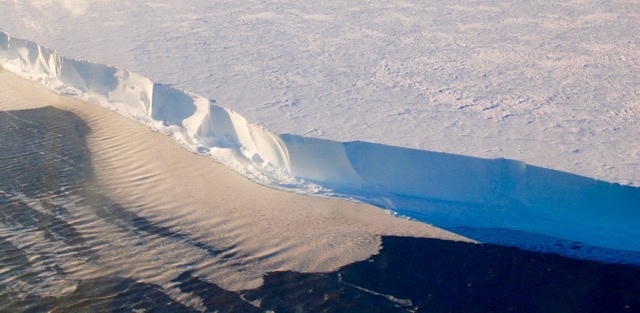
Key Part of World’s Largest Ice Shelf Melting 10 Times Faster Than Average

The front of the Ross Ice Shelf floats in the Ross Sea, as seen from the cockpit of an LC130 aircraft flown by the New York Air National Guard. Matt Siegfried / Flikr
Parts of the world’s largest ice shelf are melting 10 times faster than the shelf’s average rate, and this could have worrying implications for sea level rise.
The finding is part of a study of the Ross Ice Shelf, a block of ice about the size of France, which plays an important role in stabilizing the rest of Antarctica, as BBC News reported.
Part of the world’s largest ice shelf is melting 10 times faster than expected due to solar heating of the surrounding ocean https://t.co/GoXbabmbS5 #climatechange @scottpolar @niwa_nz
— Cambridge University (@Cambridge_Uni) April 29, 2019
“Previous studies have shown that when ice shelves collapse, the feeding glaciers can speed up by a factor or two or three,” study co-author Dr. Poul Christoffersen of Cambridge’s Scott Polar Research Institute said in a University of Cambridge press release. “The difference here is the sheer size of Ross Ice Shelf, which over one hundred times larger than the ice shelves we’ve already seen disappear.”
Basal melting of Ross Ice Shelf from solar heat absorption in an ice-front polynya https://t.co/JVlZgOtvv2 pic.twitter.com/DqiopF8nn5
— POPapers (@geomatlab) April 29, 2019
The study, published in Nature Geoscience Monday, was based on four years of observation of how the Ross Ice Shelf’s north-west sector interacted with the ocean surrounding it. Researchers found that the sun was warming surface ocean water, which was in turn melting the shelf at rates higher than they had expected.
“The stability of ice shelves is generally thought to be related to their exposure to warm deep ocean water, but we’ve found that solar heated surface water also plays a crucial role in melting ice shelves,” first author Dr. Craig Stewart from the National Institute of Water and Atmospheric Research (NIWA) in New Zealand said in the press release.
The finding that the ice shelf is so sensitive to surface ocean temperatures means it is likely to melt even faster in the future, Stewart said, since climate change is likely to melt sea ice in the Ross Sea, leading to a warmer ocean surface.
Scientists discover that ocean water warmed by the sun is melting part of the world's largest ice shelf 10 times faster than the overall average. https://t.co/xuYztk82M4
— CNN Philippines (@cnnphilippines) April 30, 2019
The researchers stressed that the ice shelf is currently stable, but is more vulnerable than previously thought. That vulnerability is enhanced by where the sped up melting is taking place. The warm surface water is flowing into a cavity near a pinning point: a place where the Ross Ice Shelf pushes against Ross Island, helping to stabilize the shelf. If pressure on that pinning point is reduced, the ice shelf could become less stable, British Antarctic Survey (BAS) oceanographer Keith Nicholl said, as CNN reported.
“These ice front pinning points help control the flow of a lot of Antarctic ice shelves, and so the study demonstrates another vulnerability of ice shelves to climate change,” Nicholl said.
That means that melting in this one area could have a wide impact on surrounding glaciers.
“The observations we made at the front of the ice shelf have direct implications for many large glaciers that flow into the ice shelf, some as far as 900 km (approximately 559 miles) away,” Christoffersen said.
If all the major ice shelves in the world collapsed, BAS said sea levels could rise several meters or more, CNN reported.

 233k
233k  41k
41k  Subscribe
Subscribe 